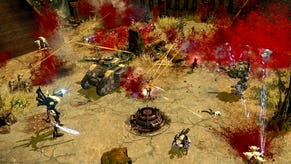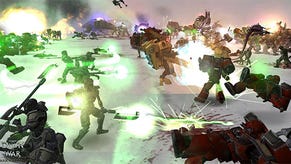Wot I Think: Dawn of War II
Dawn of War II, sequel to Relic's much-expanded Warhammer 40,000 RTS, was released to shelves and fat pipes just a few days ago. After a long weekend snuggling up to it, here's wot I think of its explodey delights.
According to the Sacred Creed of games writers who genuinely care about games writing, it is not the done thing to dedicate several paragraphs of a review to a game’s graphics and sound. Books shall not be judged by covers, pop bands not by their singers’ facial hair and a man not by what socks he is wearing. When it comes to Dawn of War II however, it’s incredibly difficult not to dwell obsessively on its excellent aesthetics. Once in a while, it's fine to be shallow.
Dawn of War II is one of very few (perhaps even the only) strategy games I’ve played in which I could swear blind those little guys are truly fighting. They’re not just going through the motions, falling over at the right moments and flailing with intangible swords at a handful of pixels somewhere near their target. This is proper, meaty carnage. Melee troops collide with bone-crunching thuds, grenades scatter corpses outward in an orbiting ring of death that smashes through walls and vegetation, while dozens of subtle,tiny animations grant your troops a visible grim resolve: men fighting and responding to the fight, rather than robotically awaiting your instruction. Its graphics are not especially high-tech – instead they’re precise, artful, thoughtful and absolutely Warhammer 40,000.
Even when playing the fortieth near-identical mission in DOW2’s oddball but extraordinarily compulsive singleplayer game, the ennui was kept at bay by the simple, giddy joy of coolly cueing up and then watching the stunning slaughter. This is a game that lives up to the auto-mythology of Space Marines: the brutality and invulnerability the fiction has always claimed of these quasi-religious, ultra-militaristic warrior-fanatics, but that they’ve so rarely displayed in any game adaption, whether on the tabletop or on the screen.
In DOW2’s single player, a small handful of Blood Ravens can manfully hold off a veritable horde of Orks or Tyranids: in the course of one level, your dozen-odd men will decimate hundreds. While in DOW1 they were common, dispoable grunts, here each and everyone one of them is Schwarzenegger in power-armour. Or Terminators in Terminator armour, to recklessly mix a couple of fictions.
In multiplayer, they’re much closer to their more lightweight DOW1 incarnation. That they’re such powerhouses in singleplayer is key to how that mode works and suceeds, and how it differs from both DOW1 and from the rest of the genre to which it in theory belongs. The Diablo comparison has come up often, but it’s perhaps a little closer to Dungeon Siege. You’ve a party rather than a character, and there’s a reasonable degree of autonomy to them. Not that they’ll win the day left to their own devices, but each of your four squads (chosen each mission from a pool of six) can generally hold the line until you hop over to them and activate one of their joyously devastating special attacks.
It’ll be interesting to hear what favourite units you lot settled on: it seems to me that the spectacular allure of the rocket-jumping Assault Marines (wooosh-BAM!) and, eventually, the gloriously cataclysmic Dreadnought is so much that, like me, you’ll find yourself neglecting some perfectly capable but less exciting squads. Thanks to canny balancing, each squad is of equal usefulness of the field - the snipey, frail Scouts are as lethal as several tons of armoured mech if you use 'em right - so it really does come down to playing favourites.
Not that it matters. The reason to play is to entertain yourself, and ascertaining the attack combinations that both deal out the most damage in the quickest time and most delight your eyes is the lynchpin of that. In singleplayer it is an action-RPG more than it is an RTS, but surprisingly the desire for more experience points and loot isn’t its backbone. Part of that is that you know in advance what the main reward for each mission will be. This neatly removes the obsessive hunt for stuff during the mission. You know full well you’re going to get that shiny prize anyway, so you can relax and enjoy the fighting that much more.
Bar a few attempts at scripted boldness in the game’s twilight hours, that every mission plays out the same is a glaring and baffling problem. Carve through a swarm of Eldar, Orks or Tyranids, restocking on special attack ammo and fallen troops en route, then fight a boss creature with a ton of hitpoints and a couple of area of effect abilities. Again and again. It only works because it looks and feels so splendidly visceral. Basically, it’s appealing to the same part of the brain that makes otherwise clever people watch 24: things get killed, stuff goes boom and there’s always some new menace waiting in the wings. But while Kiefer Sutherland has arguably outstayed his frowning welcome after seven years of torturing foreigners, this is lean enough to get away with what’s otherwise really short-sighted design. Inevitably there’ll be an expansion pack, but Relic simply cannot get away with another campaign along the same lines.
As it is, the nearly tactictless singleplayer mode is going to outrage anyone who appreciated DOW1 for its strategy rather than its fiction. You’ll fall into a pattern of special attacks (wooosh-BAM!) so devastating that there’s really no need to experiment with anything else. It’s a real shame you can’t change the difficulty between missions; partway through, Medium was generally a bit too easy for me, but I didn’t want to start over and thus abandon all the cool kit I’d collected. It’d work a bit better if, rather than being 15-odd hours of progression, it was something you could drop into to have a capsule Warhammer 40,000 experience whenever you wanted and on the terms and difficulty you wanted. Something like Left 4 Dead, really. Today I want a hardcore challenge, but tomorrow I might just want to blitz through for giggles.
The multiplayer itself I found to be weirdly less engaging. It’s a curious hybrid of DOW2’s enjoyably shallow and simplistic singleplayer and DOW1’s traditional commanding and conquering, and comes up a bit lacking on both counts. It shares the singleplayer’s wondrous explosiveness, but not the invincibility you feel when you’re decking dozens of AI Tyranids. The Company of Heroes-derived cover system, something that’s often entirely optional in singleplayer, grows in importance hugely, and vehicles enter the fray properly, so it’s bound to be a big hit in online-land. It’s just that, with the limited troop numbers and types and the hugely reduced base-building, it feels so short on scale after DOW1’s cruder but titanic mass-clashes.
I do enjoy the multiplayer, and especially that it's so setup for co-op play, but I’m simply not compelled to play it as I am the singleplayer. It feels so obviously compromised, as though it’s not where the developers passions lay. The singleplayer suggest Relic are keen to expand their hitherto strategy-only repertoire, to make something new and different, but the multiplayer feels almost like grudging fan service. Again, the approach the expansions take will be fascinating. Simply more factions will be the obvious approach (the Imperial Guard make a few cameos late in the singleplayer, incidentally), but a smarter one may be to grow the game as a whole.
Dawn of War II is equal parts success and failure. The former ends up winning through by a comfortable margin: it may be as shallow as High School Musical, but just like that it knows it, and moreover exactly what it's doing. In short, sharp doses it’s as outright entertaining as either any RTS or any Diablolike has ever been. Often, it’s more so: wooosh-BAM! never gets old.
It’s also the best realisation of Warhammer 40,000’s maximalist dark sci-fi I’ve ever had the pleasure to clap geeky eyes upon. Incredibly well-presented, brief cutscenes and talking heads consistently remind you of the war-torn universe you’re frolicking in, and the narrowed focus and scale compared to DOW1 makes it seem like a genuine slice of 40K lore. Its predecessor, by comparison, always seemed like a Greatest Hits of Warhammer 40,000: plenty of colour and variety, but weirdly out of context, our favourite units dancing for us artificially. This, however is pure 40k. In the Grim Darkness of the Far Future there is only War. And wooosh-BAM!














